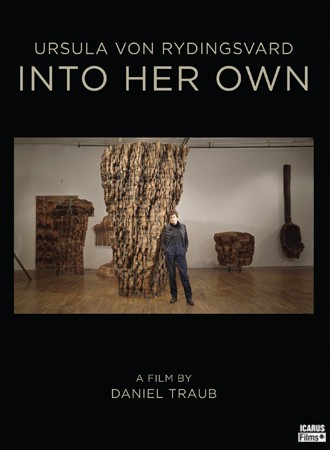
Ursula Von Rydingsvard: Into Her Own 2019
Distributed by Icarus Films, 32 Court St., 21st Floor, Brooklyn, NY 11201; 800-876-1710
Produced by Ken Kobland and Morning Slayter
Directed by Daniel Traub
Streaming, 57 mins
High School - General Adult
Biography; Immigration; Sculpture
Date Entered: 07/08/2020
Reviewed by Catherine Michael, Communications & Legal Studies Librarian, Ithaca College"Into her own” is the artist’s reference to her artwork; for the filmmaker Daniel Traub, it refers to the artist’s journey. This portrait presents the making of a sculptor, Ursula von Rydingsvard, in the context of the mid-twentieth and early twenty-first centuries. As a child she, with her Polish family survived a Displaced Persons (DP) camp during World War II and emigrated in 1950 to a working-class town in Connecticut.
After a difficult divorce from her first husband, she moved to New York City in the 1970s as a single mother. Despite meager earnings that drew her into the gritty streets of Manhattan, she relished the artistic vibe of community and became part of it. Her daughter Ursula Anne von Rydingsvard (Ursie) remembered the sound of her mother, on the studio side of their thin apartment wall, using chainsaws to make sculptures as her bedtime lullaby.
Von Rydingsvard taught classes, attended Columbia University, and ultimately established a reputation for her unique vision in creating monumental abstract sculptures. The documentary mentions her teaching career but does not cover that period -- presumably as the focus is on her artwork.
Critics, family, fellow artists and Ursula herself describe myriad aspects of her character from her use of touch, her Polish heritage, her intense desire to be an artist, her processing her tribulations through art, and her inspiration from nature.
A seminal moment was the introduction of cedar planks by a monk; she was excited by the possibilities. We see her work in unison with a group of studio helpers; she sets the exacting vision and they assist in the execution through cutting and putting the pieces of the puzzle into the scheme. They dine and work like a close-knit family.
She is not confined to one medium; the film depicts her versatility with materials. Although known for her cedar works, her use of fiber art, copper and finally bronze are shown. She takes materials from nature, breaks them down, and recreates them through her vision to a new nature. Nature, she explains, is her best teacher. She treats her art as feminine, and she addresses it like a sailor his ship. One piece of art is called Ona which is she in Polish.
A trip to Poland with her husband later in life reveals that some of the sculptural shapes harken back to where she was born: ladles for food, the sheaf of hay, the very landscape. Von Rydingsvard recalls how, in Poland, everything was made of wood; we see footage and photos of houses with intricately shaped gingerbread and piles of wood. Such detail might emerge in the intricate lace of her bronze sculpture in a later scene. Her hard-working father is described as chopping wood with strength and persistence. This same disposition was inherited by the artist who, as testified by her colleague, would not slow down even upon achieving success. The father’s stern character is a clue to the artist’s ceaseless motivation; he told her that she would not be a success and she has spent her life proving him wrong.
We also meet her second husband, the late Paul Greengard (d. 2019), a Nobel Prize winning neuroscientist from Yale. In contrast to her father, he championed her and her work.
The film was well paced and the short length, at 57 minutes, must have left a lot of footage on the cutting room floor. One explanatory subtitle over the Princeton copper sculpture said the filmmakers followed her for over a two-year period, yet this sculpture is just one of many featured. The only point of confusion in the editing, and it is not a terrible one, was the movement of the artist from Connecticut to NYC in 1975; a series of interview clips with von Rydingsvard and her brother describe her move which creates a small redundancy.
The voice-overs and music effectively complemented the transformation she went through as a budding artist. The music by Simon TaufiQue enhanced the flow of the narrative, the interviews provided context, and the soft, contemplative, monotone of the artist’s voice leads you like the Pied Piper. One example of this is the creative montage of women artists that inspired and created a community for the artist during her time in New York City. Another is towards the end of the documentary while she reflects, again, on the pain her father gave her – and how she is glad she was able to transform that pain. Finally, the music and editing also conveyed the euphoria she expressed as she viewed the perfect patina of her sculpture in one of the final scenes.
Despite her established reputation in the art world, her name is not as familiar as a Cindy Sherman or a Maya Lin, both subjects of documentaries. This film is an admirable introduction and celebration of her life and work. With plentiful images of Von Rydingsvard’s commissions in esteemed locations, we end with an appreciation of her life struggles and how those struggles informed her art and brought her "into her own.” If you happen to view one of her sculptures in person, be sure to touch it – she wants the warm effect of touch over time from curious admirers.
Awards:
Vancouver International Film Festival, Official Selection (2019); The Sante Fe Film Festival, Official Selection (2020); Architecture Design Art Film Festival, Official Selection (2020); Hamptons Doc Fest, Official Selection (2020); Film Arte Festival, Madrid, SemiFinalist (2020)